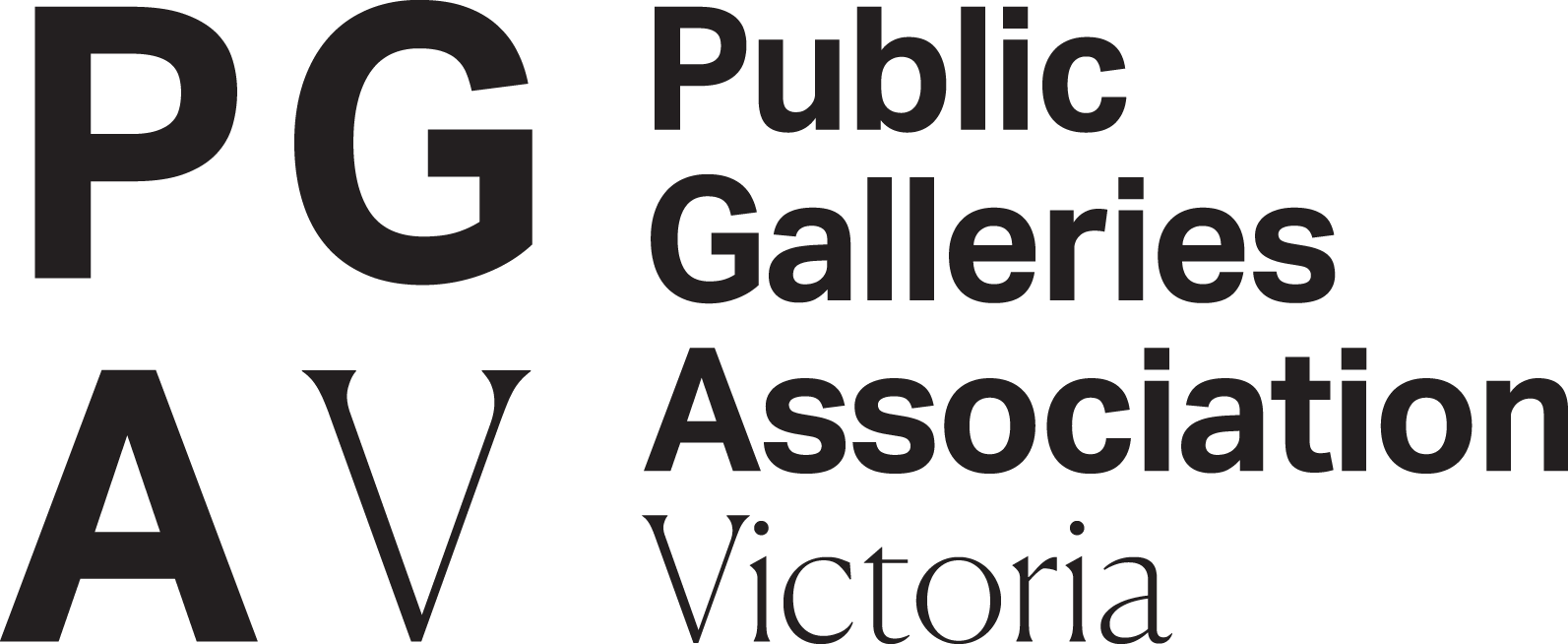
ELIZABETH PARSONS

Elizabeth Parsons
Private Collection
This special series of online newsletters celebrate the outstanding contribution of members, past and present, artists and events.
Elizabeth Parsons has been included with the Heidelberg School artists, for her role as an artist and teacher, and an advocate of plein air painting.
She was a pioneer for women artists of this period and regularly contributed to the exhibitions held by the Victorian Academy of Arts. In 1875, she was elected, against considerable opposition and voicing of disapproval from her male counterparts, as the first woman Council Member of the Victorian Academy of Arts, Eastern Hill, later the Victorian Artists' Society, paving the way for other professional women artists to be accepted on future executive positions.
Art Historian, Andrew Mackenzie OAM details the life and art of Elizabeth Parsons for this Newsletter.
ELIZABETH PARSONS
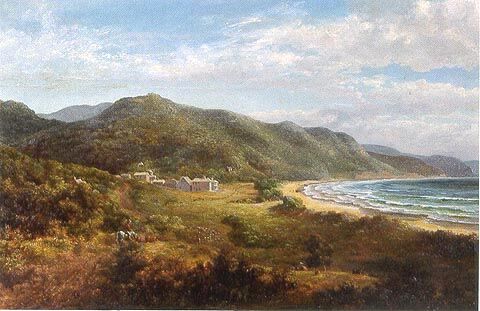
LOUTIT BAY, 1879
Private Collection
Lorne is a popular tourist resort on the shores of Bass Strait, situated 140 kilometres south west of Melbourne on the Great Ocean Road. The township is nestled between the Angahook-Lorne Park and Loutit Bay.
The Kolahngat (Volijon) Aborigines are thought to have occupied the area before European settlement.
Originally the area was given the name Loutit or Loutit Bay after Captain Loutit who called there while on a voyage to London in 1841, with reportedly the first consignment of wool from Geelong.
In 1869 (although some records have 1871), the name of the township was changed to Lorne. Some say that it was named after the Marquis of Lorne, while others say that it was named after the town in Argyllshire, Scotland. The bay however, on which Lorne stands, retained the name, Loutit Bay.
Elizabeth Parsons visited Lorne over the Christmas, New Year period of 1879-80, and there produced a number of oils and watercolours, depicting Lorne and Loutit Bay. Among the works she produced were a watercolour of 'Lorne Jetty', painted in 1879, and another watercolour 'View Across Loutit Bay', painted in 1880 which depicts very much the same view as her oil 'Loutit Bay', painted in 1879 and reproduced here.
Elizabeth Parsons probably ventured to Lorne on the Cobb & Co. coach service that had recently been established to this area of the coast, to meet the demand from Lorne's increasing popularity as a health and holiday resort for tourists. A Lorne correspondent to the Geelong Advertiser in 1877 noted that 'even at far-away Lorne, the arrival of three thousand visitors was anticipated during the season of 1877'.
In this work of 'Loutit Bay', Elizabeth Parsons provides with a view across Loutit Bay and a view of the small, but growing township of Lorne. The view is from a vantage point a little to the west of the southern end of Loutit Bay, looking towards the north. In the foreground, the stockmen on their horses are moving cattle along an old bush track that winds its way between the township of Lorne and the beach. Today, the Great Ocean Road follows much the same track, as it hugs the coastline, winding its way south west, towards Wye River. Wye River derived its name from the Welsh word 'wye' meaning 'water'.
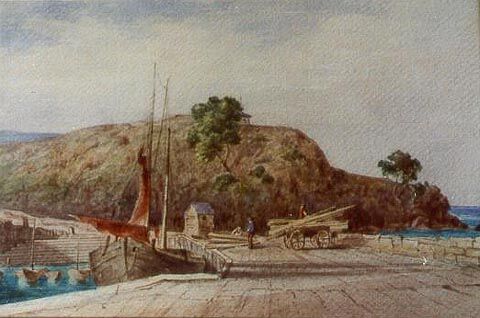
THE PIER, MORNINGTON, c. 1884
Private Collection
In this watercolour work, Elizabeth Parsons has depicted the old Mornington Pier, and some workers with a cart unloading wood, possibly to be used for repairs to the pier. Mornington was considered one of the 'beauty spots' on Port Phillip Bay, and was one of the destination points for the Bay Excursion Steamers. Artists would join the many other day-trippers, and the approach to the pier at Mornington, became a well-known landmark, and one that was photographed by many and later reproduced on postcards.
Mornington was named in 1864, and became a Shire on 24 November 1871. Before 1864, the area was known as Schnapper Point, which is the Point shown in this work, to the west of the pier. The road to the pier is now called Schnapper Point Drive. This was one of the areas that W.M.K.Vale, father of May Vale, speculated in land.
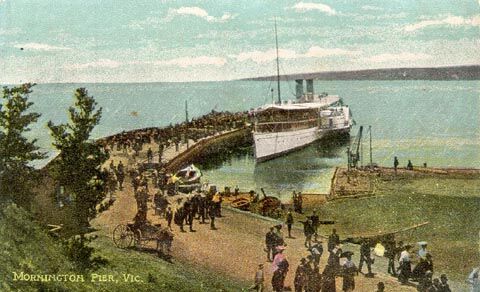

Not long after this work was painted, Tom Roberts, Frederick McCubbin and Louis Abrahams, established their Artists' Camp on Houston's property, on the rise above his bark hut, close to Damper Creek.
Today Damper Creek is known as Gardiner's Creek, and the open rolling hillsides depicted in this work, with only one or two homesteads, are now home to the busy suburb of Box Hill.
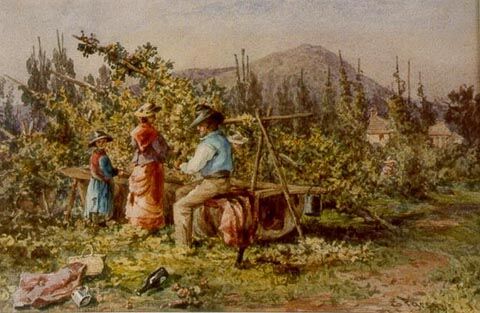
HOP-PICKING AT MYRTLEFORD, c. 1888
Private Collection
Around 1888, Elizabeth Parsons produced watercolour landscapes of various Victorian country towns. She captured in these works the old buildings of the towns as well as local activities.
In this work she has captured the hop-pickers, working in Myrtleford. They seem to be working at a fairly leisurely pace, and the remains of their alfresco meal, and the empty bottle of wine at their feet, would suggest that these hop-pickers were not too stressed by the task at hand.
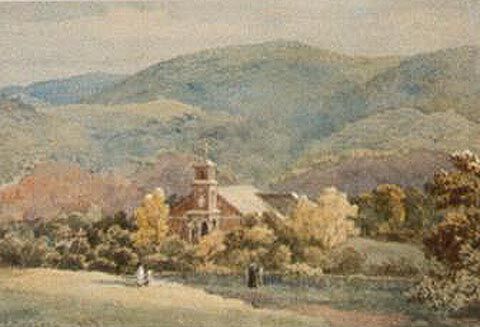
THE COUNTRY CHURCH, 1888
Private Collection
This watercolour was painted around the same time as her work 'Hop-picking at Myrtleford'. It is delicately handled, with the church and its well-kept gardens in the centre of the work, and behind the towering mountain ranges.
Elizabeth Parsons left us no clues to the whereabouts of this church, although some historians believe it may be Kilmore while others have suggested Woodend.

AN INSIGHT INTO THE LIFE OF ELIZABETH PARSONS AND HER ART BY LEADING ART HISTORIAN - ANDREW MACKENZIE OAM
"Elizabeth Parsons, painter, lithographer and teacher, was born on 27 September 1831. She was the daughter of George Warren, and his wife, Elizabeth, of Holly Lodge, Isleworth, England.
It has been recorded that 'she apparently inherited a talent for drawing from relatives who were surveyors and teachers of drawing'. Her early art studies were under Newcastle watercolourist, Thomas Miles Richardson, and James Duffield Harding, at that time considered to be the 'greatest painter of foliage in Europe'. The teachings of Harding, who was also a painter, lithographer and writer on the principles and practice of art, had a profound and lasting influence on Elizabeth Parsons, who later advertised herself as being a 'Pupil of J.D.Harding'.
She undertook further studies in Paris, and visited the 'Barbizon' Artists' colony. A number of these works that she produced in England and France, she later included in her exhibitions in Melbourne.
One of her earliest known watercolours, is 'The Thatched Cottage, Cornwall', which she produced in 1866, and signed E.Warren. This was possibly painted on one of her visits to see George Parsons, who resided in Cornwall.
On 28 October 1868, she married George Parsons, born 3 January 1830, who at the time of his marriage managed a Cornish Marble Mine, 'The Serpentine'.
Soon after the marriage, Elizabeth produced several more watercolour works, one a 'View of the Cornwall Coast', and the other, a very large watercolour, which was a view of 'The Thames at Isleworth', close to where she was born.
Her husband's first wife had died in 1864, and his two surviving sons from his first marriage were George, born June 1859, and Cecil, who was born in 1861. Elizabeth's first child was a daughter, who was named Adeline. She was born in England on 10 August 1869, and died on 21 December 1949.
The Parsons departed England on 19 March 1870, bound for Australia, aboard the S.S.Great Britain, (Voyage 35) of 57 days. They arrived on 20 May 1870. Elizabeth and George had on board with them, the two boys, George and Cecil, and seven month old, Adeline. Elizabeth was pregnant with Henry. Henry was born on 12 October 1870, and between November 1870 and 1872, Elizabeth gave her address as 3 Gratton Place, Keppel Street, Carlton. Her son, Warren was born on 30 July 1872, and died on 11 March 1905.
On her arrival in Australia, Elizabeth Parsons wasted little time in establishing her reputation as a professional artist. As early as 1 December 1870, her works were shown in an exhibition of 'Works by Victorian Artists', that was opened by Viscount Canterbury at the Melbourne Public Library. In all, two hundred and thirty works were shown in this exhibition, and this included works by O.R.Campbell, Louis Buvelot, and Eugene von Guerard. Elizabeth Parsons' works were highly praised, as 'landscapes of conspicuous merit', and in the Argus review of the exhibition under the heading 'Exhibition of the Victorian Academy', her five watercolour works must have been of considerable quality. Given the stature of the male artists, with whom she was exhibiting, the review was high praise, and noted
'In the watercolour department there are no better landscapes than those painted by Mrs Parsons'.
She adapted to painting the Australian landscape, in oils and watercolour with little trouble, and again successfully exhibited her watercolour works in 1872.
Her watercolour works, apart from landscapes, also included delicate recordings of Australian flora, such as Boronia, Lobelia Gibosa, and the Blue Tinsel Lily.
In January 1873, her husband, George became the Inspector and Auditor on the North Eastern Railway - Seymour and Avenel, and at this time, Elizabeth gave her address as 23 Stephen Street, South Melbourne. During this year her works were accepted for the London International Exhibition.
Between 1874 and 1878, she gave her address as Neptune Street (off Grey Street), St. Kilda.
Her fourth born child was another son, Noel, born on 6 January 1875, and her fourth son, and fifth born child, Jonathon, was born on 18 August 1876. One would have to assume that she had a nanny to look after her children, especially when she went away on one of her many painting excursions to distant and remote areas.
She regularly contributed to the exhibitions held by the Victorian Academy of Arts, and in 1875, she was elected, against considerable opposition and voicing of disapproval from her male counterparts, as the first woman Council Member of the Victorian Academy of Arts, Eastern Hill, later the Victorian Artists' Society.
She had a forceful personality, and made the way easier for future professional women artists to gain recognition, and to hold executive positions on Art Societies. Also, through her Council position on the Victorian Academy of Arts, and her teaching, she had a marked influence on the standard of the art in the community, especially that of women's art, and was a strong advocate of the watercolour medium.
Her early years in Australia were spent between raising her young family, her commitment to the Victorian Academy of Arts, and her teaching. It has been recorded that even in her early years, she was considered 'a successful painter and art teacher', and one of her pupils was her son, Henry, who also became an accomplished artist.
During 1876, one of her English oil subjects and two Australian watercolours, were sent, with the exhibition, as part of Victoria's offering to the 1876 Philadelphia Centennial.
For a short while in 1877, she lived in Berwick, and gave her address as Wilson Road (off Lyall Road), Berwick. She drew and painted a number of works in the vicinity of this country town, as well as producing works of Lilydale. Her Lilydale watercolour views were exhibited in 1877 with the New South Wales Academy of Art, and were ranked among the best exhibits. Her husband meanwhile, was employed as Auditor and Inspector on the Gippsland Railway Contract.
Like Louis Buvelot, she was an early advocate of painting plein air, and her travels in search of new subjects took her to many remote areas of Victoria, as well as to interstate, and overseas locations. These locations included places as far afield as Woodend and Maffra, Phillip Island, Kalimna, on the Gippsland Lakes, the Blue Mountains in New South Wales, various areas of Tasmania, and remote areas of New Zealand. Her strength and determination to travel to these areas was remarkable, especially for a woman, for in those days, women did not travel by themselves great distances away from their home and family. Also, her only means of transport would have been by train, and to some destinations, boat, coach, or horse and cart.
One of the works she produced at this time while on one of her painting excursions, was 'Loutit Bay', 1879, an area to which the Cobb & Co. coach had only recently established a service. On the reverse of this work is the inscription 'Mrs George Parsons. Charnwood Road, St. Kilda'. This was an oil painting, however, she also at this time produced a number of watercolours. One, known as 'Lorne Jetty', was painted in 1879, and is a view along the beach at Lorne, towards the Jetty, while another, 'View across Loutit Bay', painted in 1880, is a very similar view to that of the oil 'Loutit Bay, 1879. From the dates of these works, it would seem that they were painted over the Christmas, New Year period of 1879-1880, and would suggest that Elizabeth Parsons stayed in Lorne, possibly at the newly opened Erskine House, or local Hotel, that was also newly opened.
Elizabeth Parsons continued exhibiting her works, and included two oils and three watercolours in the International Exhibition, held in Sydney, 1879-1880. She also exhibited three oils in the Melbourne International Exhibition, in 1880-1881.
Along with Frederick McCubbin, Clara Southern and Jane Sutherland, she was one of the early members of the Buonarotti Society, which was formed in 1880. Cyrus Mason was its President, and the Society has been described as 'a source of semi-Bohemian culture in the Melbourne of the late eighties'. When the Buonarotti Society ceased, Elizabeth Parsons formed a new society, which she named the 'Stray leaves', and which was designed to 'bring together and encourage young people interested in art'.
On 26 August 1880, her next infant was still-born, and between 1880 and 1885, she gave her address as 'St. Ruan', Charnwood Road (off St. Kilda Road), St. Kilda.
In December 1880, two of her works depicting 'Views at Heidelberg', which were shown in the first exhibition of the Sydney Art Society, were highly praised, and she continued exhibiting with this Society for several more years.
In 1881, she exhibited one of her French works, 'At Fontainebleau', with the Art Society of New South Wales, and in the 1881 exhibition of the Victorian Academy of Arts, her love of poetry and literature found expression in the naming of her works.
She gave the following as the title for one of her entries in this Victorian Academy of Arts exhibition:
Apart from the recognition given to her watercolours, she was also recognised as an accomplished drawer. Probably because of the interest in her drawings, around 1882, she decided on an enterprising commercial venture, to publish a set of lithographed drawing books on Australian landscape, in three parts. The title of this set was Drawing Book of Australian Landscape by Mrs George Parsons. 'Pupil of J.D.Harding'. Each of the drawings in Part one were dated 1882.
In 1884, six of her watercolours were accepted for inclusion in the Victorian Jubilee Exhibition, and in 1886, she won First Award in the Watercolour Landscape Section, and was presented with a silver medallion in the Bendigo Juvenile and Industrial Exhibition.
In 1884, she produced a number of watercolours, depicting views of different 'beauty spots' around Port Phillip Bay, and two of these works, are her 'View from Ricketts Point', and 'The Pier, Mornington'.
She also travelled to New Zealand in 1884 to visit relatives, and produced a number of large watercolour landscapes, of which 'Mount Alfred and Lake Wakatipu, New Zealand' is a fine example. Works that she produced while on this New Zealand trip, she later exhibited in Melbourne.
In the following year, she painted a watercolour, 'Box Hill Landscape', 1885, and this is interesting, for it was around this time that Tom Roberts and his colleagues were discovering the same area, and shortly after established the Box Hill Artists' Camp.
In 1886, she also had works accepted for the Colonial and Indian Exhibition in London, and her work 'The Red Bluff' from this exhibition was highly praised and reproduced in the Magazine of Art.
In 1887, she travelled to Hobart, where she discovered the beauty of Montagu Bay. Here she produced one of her largest, and most dramatic watercolours, 'Montagu Bay, Tasmania', with cloud shrouded Hobart and Mount Wellington in the distance.
In 1888, she continued her travels, this time to Victorian country towns, and produced a number of watercolour landscapes, depicting the country scenery, the buildings and the people at work. Two of these landscapes, are 'The Country Church', and 'Hop-picking at Myrtleford.'
She continued to exhibit her works in Melbourne, and this included the Melbourne Centennial International Exhibition, held in 1888-1889.
Read further about Elizabeth Parsons life HERE.
The Victorian Artists Society
Media Enquiries:
Ron Smith OAM Hon FVAS, Victorian Artists Society - Mobile: 0417 329 201
Acknowledgment of traditional owners.
We would like to pay our respects to the traditional owners of the land on which our building stands, their leaders, past, present and emerging.

